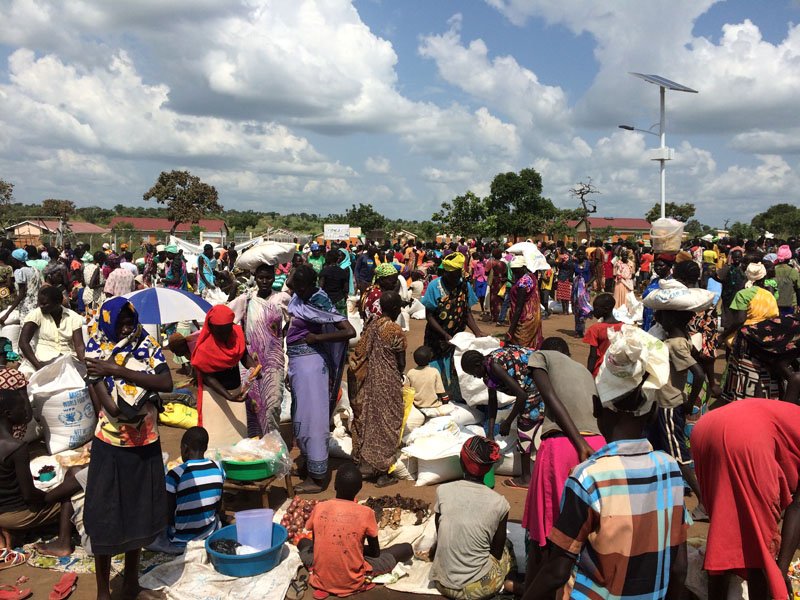Over the past three months, an average of more than 2,000 South Sudanese a day have crossed into Uganda, seeking safety from bloodshed at home. Aid groups and government agencies are scrambling to shelter and feed everyone. The influx has not abated since fighting reignited in the South Sudan capital of Juba in July. To date, more than 1 million South Sudanese—mostly women and children—have fled to neighboring countries. Uganda has the most—432,619 as of last week. And the crisis is nearing a tipping point. “We have a shortfall of about $27 million for the next six months,” says Cheryl Harrison, World Food Program Uganda deputy country director.
Going Hungry
In August, the funding shortage forced WFP to cut food rations in half for roughly 200,000 refugees who arrived before the current emergency (violence also erupted in 2013, and hundreds of thousands of South Sudanese refugees have come since then).
Twenty-seven million is not just a number on a spreadsheet. It’s a visceral pain in the stomachs of South Sudanese who no longer eat full meals. “Sometimes I go to bed hungry,” says 18-year-old Isaac Biar, who has lived with relatives in Ayilo Refugee Settlement in northern Uganda for the past few years. Like everyone around him, he is entitled to monthly allotments of sorghum, maize, beans, corn-soy blend, cooking oil and salt. Under Uganda’s refugee settlement system, Biar’s family also has a small plot of land for growing vegetables such as corn, okra and peas to supplement their rations.
Many refugee families say they had just enough food to survive before the cuts. Now, they don’t. “That sorghum cannot last for one month,” says 12-year-old Mayen Isaac, Biar’s friend, who eats just one meal a day now, in the evening. The two were schoolmates in South Sudan. They reminisce about eating meat and fresh river fish, which they don’t get at all in Uganda.
“Children are now suffering from diseases,” says Rachel Ayen, a 29-year-old tailor in a small Ayilo market. In 2014, she says, her hometown in South Sudan was bombed. She escaped to the bushes for three days, then to a swampland for a month before making it to the Uganda border, and eventually to Ayilo. Her husband, a soldier, remained in South Sudan, but she’s been living here with her five kids. At first, she says, the rations were enough. But not now. “Children now are suffering from diseases.” Ayen says she has seen kwashiorkor, a form of malnutrition caused by protein deficiency and characterized by an orange coloring of hair, potbelly and edema. Local health workers report high rates of malnutrition among refugees, as well as malaria and other diseases.


What is the answer? I ask Ayen. The solution, she says, is to increase rations. If that doesn’t happen, “people will be going to South Sudan.” They will risk their lives, returning to their war-torn home to find food—although she doesn’t think there is any food in South Sudan, either.
When I ask WFP’s Harrison what the solution is, she replies with an equally disquieting answer. Since the organization relies on donations, it has few options when donations run short of need. That’s why rations were cut in August. “We wanted to make sure that the available resources stretched,” she says. “It’s not good for any family to have no food for an entire month. Better that households can plan a little bit and have less food.” In fact, that decision had already been made before fighting resumed in South Sudan in July. “The population of refugees that were in Uganda, and had been in Uganda for a few years, was already stretching our resources for food assistance.”
So far this year, her organization has received roughly $37.7 million in cash donations from the United States, United Kingdom, European Commission, Japan, Ireland, Canada and UN Central Emergency Response Fund; plus another $9.7 million worth of in-kind donations (food) from the United States.
It’s not enough.
Right now, Harrison says, it takes nearly $8 million a month for WFP to feed all the refugees in Uganda (including those from other countries such as Somalia, Burundi and the Democratic Republic of the Congo). “If the number of people coming into the country continues to increase at its current rate,” Harrison says, “by March it will be $9 million” every month.
South Sudan and Uganda garner relatively little attention when compared with other world news—like Syria, ISIS, Hurricane Matthew or the latest Trump-Clinton debate. But Harrison asks the world to widen its scope. “Everyone, please…follow the story that’s going on in Uganda,” she says. “There’s a very big crisis here.”
I think of what such a funding shortage in international aid means for the refugees I meet.
“That is life in Africa,” 18-year-old Biar says with a shrug when I ask him about hunger.
His neighbor, the tailor, is exasperated. She has five kids to feed and a future full of worry. “If we are lucky,” Ayen says, “we will be alive.”
Reporting for this story was made possible by a fellowship from the International Women’s Media Foundation African Great Lakes Reporting Initiative.
